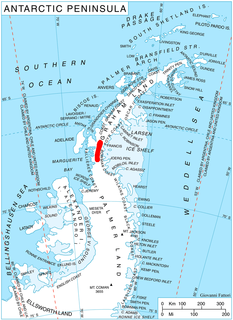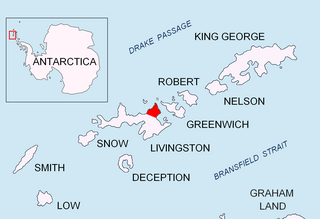
The British Antarctic Territory (BAT) is a sector of Antarctica claimed by the United Kingdom as one of its 14 British Overseas Territories, of which it is by far the largest by area. It comprises the region south of 60°S latitude and between longitudes 20°W and 80°W, forming a wedge shape that extends to the South Pole, overlapping the Antarctic claims of Argentina and Chile.

Snares Islands/Tini Heke, also known as The Snares, is a small group of uninhabited islands lying about 200 km south of New Zealand's South Island and to the south-southwest of Stewart Island/Rakiura. The Snares consist of the main North East Island and the smaller Broughton Island as well as the Western Chain Islands some 5 km (3.1 mi) to the west-southwest. Collectively, the Snares have a total land area of 3.5 km2 (1.4 sq mi).

Neny Island or is an island 2.8 km (1.5 nmi) long which rises to 675 m (2,215 ft), lying 1.9 km (1 nmi) northwest of Roman Four Promontory and directly north of the mouth of Neny Fjord, off the west coast of Graham Land in Antarctica. Neny Island was discovered by the British Graham Land Expedition (BGLE) (1934–1937) under John Riddoch Rymill and named after nearby Neny Fjord.

Northeast Glacier is a steep, heavily crevassed glacier on the west side of Hemimont Plateau, 21 km (13 mi) long and 8 km (5 mi) wide at its mouth, which flows from McLeod Hill westward and then south-westwards into Marguerite Bay between the Debenham Islands and Roman Four Promontory, on the west coast of Graham Land, Antarctica. Northeast Glacier was first surveyed in 1936 by the British Graham Land Expedition (BGLE) under John Riddoch Rymill. It was resurveyed in 1940 by members of the United States Antarctic Service (USAS), who first used the glacier as a sledging route, and so named by them because it lay on the north-eastern side of their base at Stonington Island.

Stancomb-Wills Glacier is a large glacier that debouches into eastern Weddell Sea southward of Lyddan Island. The glacier was discovered in the course of the U.S. Navy LC-130 plane flight over the coast on November 5, 1967, and was plotted by United States Geological Survey (USGS) from photographs obtained at that time. The name was applied by the Advisory Committee on Antarctic Names (US-ACAN) in 1969.

Cape Longing is a rocky cape on the east coast of Graham Land, Antarctica, forming the south end of a large ice-covered promontory which marks the west side of the south entrance to Prince Gustav Channel. It was discovered by the Swedish Antarctic Expedition under Otto Nordenskiöld in 1902, and so named by him because from the position of his winter hut on Snow Hill Island the cape lay in the direction of his "land of longing" which he was anxious to explore.

Blaiklock Island is a high and rugged, irregular-shaped island 17 kilometres (9 nmi) long, lying between Bigourdan Fjord and Bourgeois Fjord. It is separated from Pourquoi Pas Island by The Narrows and from the west coast of Graham Land by Jones Channel. The feature was partially surveyed in 1936 by the British Graham Land Expedition under Rymill, at which time it was charted as a promontory. It was determined to be an island in 1949 by Kenneth V. Blaiklock, a Falkland Islands Dependencies Survey surveyor for whom it is named.

Zinberg Glacier is a glacier in east Thurston Island; it flows east-northeast into Morgan Inlet between Tierney Peninsula and the promontory ending in Ryan Point. Named by Advisory Committee on Antarctic Names (US-ACAN) after Cpl. E. Zinberg, U.S. Army photographer in the Eastern Group of U.S. Navy Operation Highjump, which obtained aerial photographs of Thurston Island and adjacent coastal areas, 1946-47.

Alberts Glacier is a heavily crevassed glacier in Antarctica. It is about 8 miles (13 km) long, and flows east from Avery Plateau, Graham Land, until entering Mill Inlet between Balch Glacier and Southard Promontory.

Ray Promontory is the 7 km long and 2.8 km wide promontory lying between Barclay Bay and the New Plymouth sound, and forming the northwest part of Byers Peninsula, Livingston Island in the South Shetland Islands, Antarctica ending up in Start Point and Essex Point. The promontory's interior is mostly occupied by Dospey Heights.

Window Island is a small ice-free island off the north coast of Ray Promontory in the northwest of Byers Peninsula, Livingston Island in the South Shetland Islands, Antarctica. The island has a surface area of 23 hectares and rises to 72 m (236 ft). It was known to the early 19th century sealers operating on Byers Peninsula.

Broka Island is a rocky island, 7.4 kilometres (4 nmi) long and rising to 140 metres (460 ft), with a prominent cove indenting the north side, situated 3.7 kilometres (2 nmi) north of Law Promontory and 1.9 kilometres (1 nmi) west of Havstein Island. It was mapped by Norwegian cartographers from aerial photographs taken by the Lars Christensen Expedition, 1936–37. They applied the name Broka because the outline of the island resembles that of a pair of trousers.
Pitt Point is a promontory, 90 m high, at the south side of the mouth of Victory Glacier on the south coast of Trinity Peninsula, forming the northeast side of the entrance to Chudomir Cove. The promontory was charted by the Falkland Islands Dependencies Survey (FIDS) in 1945, and named for K.A.J. Pitt, master of the 1944-45.

Phelps Promontory is a large ice piedmont promontory forming the north extremity of Varna Peninsula on Livingston Island in the South Shetland Islands, Antarctica north of Zhelyava Hill. The promontory is fringed by several low-lying rocky headlands, and rises gently south to an altitude of about 180 m. Named after (Edmund) Malcolm Stuart Phelps (1928–2017), Master RRS John Biscoe, 1972-1991, who gave substantial assistance to Dr. J.L. Smellie and Dr. M.R.A. Thomson, British Antarctic Survey geologists with the field survey of this area, during the season 1974-75.

Havstein Island is a rocky island, 6 km (3 nmi) long and 4 km (2 nmi) wide, situated 3 km (1.5 nmi) north of Law Promontory and 2 km (1 nmi) east of Broka Island, in Antarctica. It was mapped by Norwegian cartographers from aerial photographs taken by the Lars Christensen Expedition, 1936–37, and named Havstein, probably because of its rocky nature and its seaward position.

Single Island is a high ice-covered island on the west side of the Amery Ice Shelf about 26 kilometres (14 nmi) south of Landon Promontory. First plotted by ANARE from air photos taken in 1956, but incorrectly shown as a promontory. Later mapped by ANARE as an island. Named by Antarctic Names Committee of Australia (ANCA) for M. Single, senior diesel mechanic at Mawson Station in 1962, a member of the ANARE field party which visited the area in December 1962.

View Point is 150m long eastern tip of a promontory, on Antarctica, forming the west side of the entrance to Duse Bay on the south coast of Trinity Peninsula, on the northern portion of the Antarctic Peninsula. Situated 6.79 km east of Skomlya Hill and 6.45 km southeast of Boil Point. Discovered by a party under J. Gunnar Andersson of the Swedish Antarctic Expedition, 1901-04. So named by the Falkland Islands Dependencies Survey (FIDS) following their survey of the area in 1945 because from this promontory, good panoramic photographs were obtained.

Roscoe Promontory is a massive ice-capped promontory between Aagaard Glacier and Mitterling Glacier on the north side of Mill Inlet, Foyn Coast, Graham Land. The feature was photographed by Ronne Antarctic Research Expedition (RARE) and surveyed by Falkland Islands Dependencies Survey (FIDS) in 1947. Named by Advisory Committee on Antarctic Names (US-ACAN) in 1987 after John H. Roscoe, photogrammetrist on U.S. Navy Operation Highjump, 1946–47, and Operation Windmill, 1947–48; author of Antarctic Bibliography, U.S. Naval Photographic Interpretation Center, Department of the Navy, 1951, and Antarctica, Regional Photo Interpretation Series, Department of the Air Force, 1953. The promontory is in proximity to several features named after Antarctic bibliographers.
Lewis Bay is a bay indenting the north coast of Ross Island, Antarctica, between Mount Bird and Cape Tennyson.













